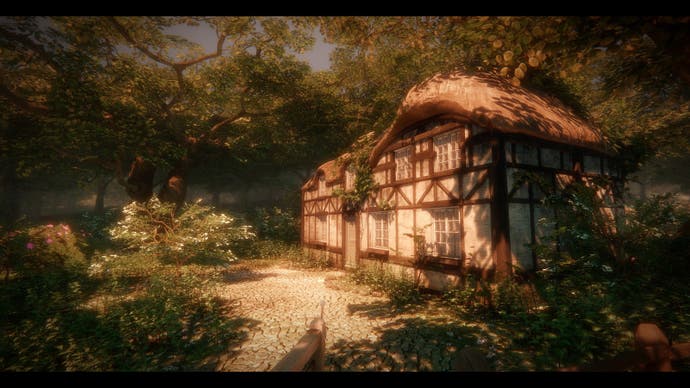Where literature and gaming collide
How games are mining literary sources of inspiration.
Game narratives tend to drink from a narrow pond; they swig space operas and Tolkien, swish them about their mouths and trickle them into rows of polished glasses.
There's nothing wrong with science fiction and fantasy, just as there's nothing wrong with escapism. But there is something wrong with lazy writing, with cynical pandering to an assumed audience. It's a good thing then that games are deepening, diversifying; that there are now game developers who draw on increasingly complex sources to inform and shape the works they make. Literary fiction has seen a growing presence in game design. While story often exists in order to thread together puzzles or rooms of enemies, some games are letting their writing spill out of pure functionality, instead taking inspiration from works which do more than push an easy plot. Take Kentucky Route Zero, whose creators - Jake Elliot and Tamas Kemenczy of Cardboard Computer - point to literature and theatre as sources of inspiration.
"Some of our first points of reference when sketching and imagining Kentucky Route Zero were in fiction - the magical realism of Gabriel Garcia Márquez and the southern gothic of Flannery O'Connor," say Elliot and Kemenczy. "We also looked early on at theatre scripts. That ended up being extremely important to us, in characterisation and dialogue and also the environment design and treatment of space, lighting and movement."

The clash between the mundane and the fantastical in Márquez's novels and the grotesque characters who occupy O'Connor's stories provide a strong pallet for Kentucky Route Zero. Likewise, theatre offers a model for the game's use of space and dialogue. So why then don't more games pull on these sources? Why is there such a dominance of blockbuster films and genre fiction?
"In general it's purely an industry historical marketing bias, in the fact that it was nerdy males who discovered video games and the industry has been selling to them ever since in the most desperately commercial way," says Tom Jubert, writer of games including The Swapper and FTL. As well as commercial reasons for game stories to centre on familiar gangs of space marines and mages, Jubert also points to a barrier at the core of the form itself. "So much literary fiction is centred around human relationships, and human relationships are famously the hardest thing to systemise and mechanise in a game. It's only natural that the industry focuses on shooting and climbing rather than talking."
As Jubert suggests, the systems offered by genre fiction facilitate much of gameplay as we have come to expect it. "Some of these genres have really consistent systemic rules and relationships (cops & robbers, orcs & elves)," say Elliot and Kemenczy, "and that makes them ready subjects for mechanic- or system-oriented game designers." In literary fiction the role between antagonist and protagonist are not always defined. The action is not always as clear as it is in a book where there are identifiable set-pieces, battles, murder mysteries. Without the pre-set systems of genre fiction, how can games engage with literature and still be fun to play?
Andalusian, designer of the upcoming Tangiers, is one developer who seems to be confronting the question. Their project, described as 'a tense stealth game set within the confines of a dark, self-destructive world' cites writers such as JG Ballard and William S. Burroughs as influences. The game will reportedly allow you to capture overheard dialogue and rip apart the sentences to use words as items. For example, if you hear someone asking 'Care for a smoke?' you can pull out 'smoke' and use it to make a smokescreen.

"On the most superficial level with Tangiers, we grant literature the same weight that we would any other reference material," says Alex Harvey, developer at Andalusian. "Passages, concepts, styles and tone standing equal to any concept art or imagery that we refer to within the creative process. Going deeper, we try to avoid just looking at raw content. We are just as interested in the intentions of text - furthermore the interactions and technique used to achieve that."
Setting out to investigate the intentions of text, Tangiers uses literature, particularly the fragmented postmodernism of Burroughs, to help shape its mechanics. Harvey suggests that this engagement with questions of language and meaning through gameplay is preferable to directly imitating literature as it exists in books:
"Actively engaging with literary fiction, contexts and formalism will inevitably grant us far deeper, far more valuable narrative experiences," says Harvey. "But literature isn't so much a golden goose where we can say 'Do it like the books do - your games will be better'. If we go in and just try to imitate written fiction we'll end up with a more verbose equivalent of 'cinematic' AAA games. Endless paragraphs of dialogue & exposition in place of cut-scenes, QTEs and uninteractive set-pieces."
While the writers at the heart of Tangiers are from the 20th century avant-garde there is obviously scope for developers to draw on other styles of literature. One developer who has consistently drawn on a range of fiction in their games is The Chinese Room, whose upcoming game Everybody's Gone to the Rapture sees you exploring a village in Shropshire during the end of the world.
"For Everybody's Gone to the Rapture, we really wanted to explore the very British apocalyptic sci-fi of the 60s and 70s," says creative direct Dan Pinchbeck. "John Christopher's The Death of Grass and A Wrinkle in the Skin, John Wyndham's Day of the Triffids and some of the really early 'cosy catastrophe' fiction like The Tide Went Out by Robert Wade."
Whereas Tangiers pulls on writers whose works are brimming with paranoia and linguistic uncertainty, Everybody's Gone to the Rapture draws on British post-war apocalypse fiction, where recognisable domestic settings are often subject to sudden catastrophic events. According to Pinchbeck, Dear Esther, The Chinese Room's breakout project, found inspiration in a similar way: "For Dear Esther, looking at the way William Burroughs worked structurally was a big influence, but also I was really interested in moving towards a quite image-heavy, symbolic, poetic use of language rather than the normal descriptive tone we find in games."
Burroughs pops up again, this time alongside poetry. It's a form that for many wouldn't normally be associated with games and in this way Pinchbeck points to a crucial issue about literature in games; that we're quite happy to be challenged in terms of gameplay but we aren't often happy to be challenged in terms of writing.

"We need to break the stranglehold that every player has to understand everything; that's keeping game writing stagnant and making it very hard to be more literary in our writing and design," says Pinchbeck. "Lots of casual players would struggle with a game as difficult as Dark Souls. We're totally accepting of the idea that a game's mechanics may be too difficult for some players, but we expect all game's stories to be understandable or engaging to all players, and that holds us back, and it's weird because we're expecting one area of game design to have the freedom to target and hone for a subset of players, whilst another isn't allowed to grow."
The problems of challenging audiences are not unique to games; art-house cinema and literary fiction do not traditionally make as much money as blockbusters and genre novels, but intellectually and emotionally challenging works are supported in these industries all the same. Importantly, these works are not left to the fringes but are held up as the best of the art-form, celebrated at festivals like Cannes or awarded with prizes like The Man Booker. As game design becomes increasingly open to diverse sources of inspiration, can games expect to see a similar growth of narratives which challenge their audience and are celebrated for it?
"It just makes logical sense to explore outside the very limited rut of blockbuster sci-fi and action movies that games have been stuck for the last decade - and actually, it's really just returning back to a style and a body of inspiration that older games in the 80s were drawing from all of the time," says Pinchbeck. "Old text-based adventures like A Mind Forever Voyaging were deeply literary, not just because they were text-based, but in their style and feel as well. So maybe we're just heading back to our roots a little."
Pinchbeck points to past examples of literary game design and yet the current cultural landscape now is hugely different from that of the 1980s, and not only for games. The author Will Self recently wrote a piece for The Guardian on the death of the novel, saying that "the literary novel as an art work and a narrative art form central to our culture is indeed dying before our eyes". The rise of games is often attributed as a cause for the decline of the novel as well as the loss of sustained intellectual attention. This is not without reason, and yet this shift in medium doesn't need to be seen as a negative change. Developers like Andalusian, The Chinese Room and Cardboard Computer are proving the rise of games doesn't need to come at the cost of serious thought.








